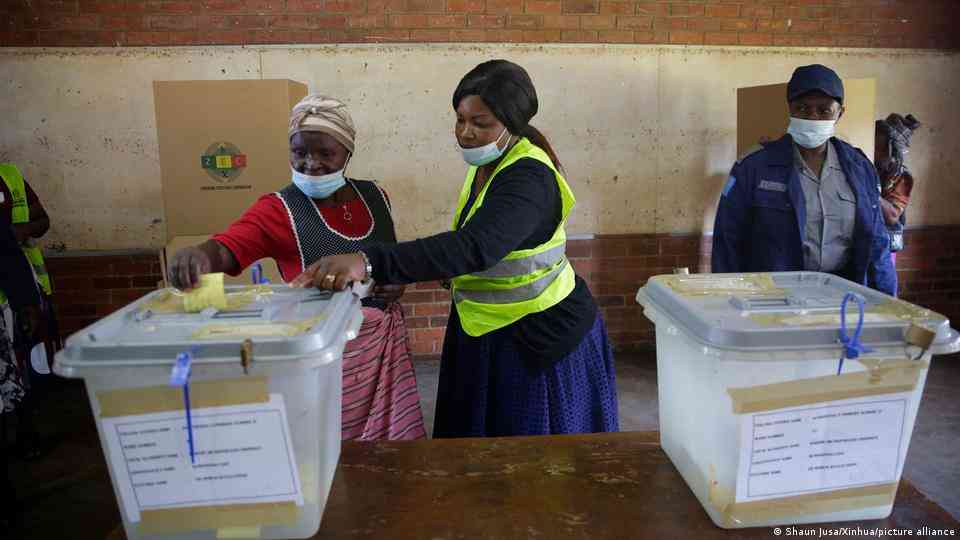
By Tatenda Chitagu Paul Warure (71), a traditional leader from Masvingo province’s south-eastern district of Bikita, believes he and many other villagers from his area are cursed as weather and climate disasters seem to stalk them every now and then.
Just a fortnight ago, they were hit by a second tropical cyclone in four years that left a trail of destruction in the area.
“We have always been victims of cyclones and droughts, and we wonder why other areas are not affected. Why us alone?” he queried to NewsDay while touring his maize crop which had been battered by strong winds.

Unbeknown to him, their “curse” is that they are settled on the pathway of recurrent cyclones that usually originate from Mozambique, leaving them susceptible yearly to extreme weather disasters. After surviving Cyclone Eline in the year 2000, they thought the worst was over.
Cyclone Eline, with wind speeds of 120km per hour, hit Zimbabwe, Zambia, Malawi and Mozambique with apocalyptic din, leaving a trail of destruction characterised by flooding which caused one of the biggest humanitarian crises in southern Africa.
In Zimbabwe, it lasted from early February to early March, leading to 136 deaths from flooding, while 60 000 houses and huts were destroyed, 15 000 toilets carved in, 54 clinics and 538 schools were damaged while 230 dams burst, but the worst was not over.
In 2019, Cyclone Idai, which was to be the most deadly of them all hit again.

At least 259 people in eastern Zimbabwe died and over 16 000 households were displaced, while 217 are still missing and unaccounted for, with the worst affected areas being Chimanimani and Chipinge districts in Manicaland, which also fall in the track of recurring cyclones.
- Chamisa under fire over US$120K donation
- Mavhunga puts DeMbare into Chibuku quarterfinals
- Pension funds bet on Cabora Bassa oilfields
- Councils defy govt fire tender directive
Keep Reading
In Masvingo province, five people died while 5 257 households were affected, with 511 left homeless, according to statistics availed by the provincial information office.
Other districts affected were Gutu, Zaka, Chiredzi, Bikita and Masvingo rural, that also fall on the cyclone tracks.
Some 13 schools were affected as well as four cells at Mutimurefu prison, about 25km outside Masvingo city. Several bridges were also washed away, while roads have been left in a bad state.
And just when Warure and his clansmen thought they would recover from the long-term effects of the two disasters, another cyclone, christened Ana — though mild, hit them again this year, this time leaving damage to infrastructure and the environment.
“When we hear of a cyclone, we get fear, we get out of our house and seek refuge in a rondavel under tables that has a thatched roof for fear of having asbestos roofs falling on us,” said Warure, who is the incoming chief Mukanganwi.
Cyclone Ana left a trail of destruction in Manicaland last month, destroying 105 houses.
In Masvingo, the cyclone, which started in the Mozambican Channel, blew roofs at several schools and clinics in Bikita, some being Mukanga Primary School, Mashoko Clinic and Nharira irrigation scheme. A villager was also left homeless after his house’s roof fell in and is admitted at a local hospital after suffering a broken leg, according to Bikita district development co-ordinator Bernard Hadzirabwi.

Hadzirabwi said due to inaccessibility of some areas as well as network problems, they were yet to quantify the total damage in the district.
“We are still assessing the damage. We are experiencing network problems, so I am yet to get more details on the extent of the damage to other areas that were affected,” he said.
Warure said Cyclone Ana hit them when they were yet to recover from the trauma caused by Cyclone Idai.
“Just when we thought we were on a recovery path from previous cyclones, this year, we were again hit by another one. Though mild, it left my house with cracks. We do not know what crime we have committed to the heavens,” he said.
While ruling out the prospect of being relocated to safer places, he called on government to avail to them cement and/or build them stronger structures that can withstand future weather hazards, including tropical storms.
Warure is not the only one with a grave fear of cyclones.
Further in the district under Chief Nhema at Mupengo Business Centre in ward 15, Monica Matizira, a shop owner who lost a Blair toilet and a grain storage room to Cyclone Idai, said this time around, she had to seek refuge at relatives in Masvingo city.
“My structures were built with cement and were strong, but last time they were destroyed by Cyclone Idai. I had to be given food by relatives as I lost one tonne of maize, a tonne of groundnuts and round nuts. I have not yet re-built. Somehow, I had sensed we could be hit again. And true to this, Cyclone Ana has hit again,” she said.

“When I heard news of the recent cyclone this year, I had to pack my bags and travel to Masvingo city. I was afraid I would be affected and cut off from help alone here. I only came back after the situation had normalised.”
This time, however, she was not affected, although she laments the damaged road network, which she said affected business as delivery vehicles no longer come, while transport fares went up.
“This time around, the roads here have been damaged and transport is now a problem as operators have ditched this route,” she said.
To avoid the effects of the strong winds, she suggested a serious reforestation drive to absorb the pressure.

“I think, we need to plant trees which can be wind shields. Mupengo Dam, from where our cattle drink water, had its wall burst in 2019 and we repaired it. Luckily, this year it was not damaged, but had it been damaged, I think the villagers would do nothing as last time we contributed and repaired it begrudgingly,” Matizira said.
Topote village head Nehemia Kudenga (47) this year counts himself lucky.
When Cyclone Idai hit the last time, he lost a rondavel hut and chicken compound, but this time, he did not suffer any damage. However, he feels government ought to come up with disaster adaptation and mitigation strategies.
“When disaster struck in 2019, those affected here in Bikita did not get any building materials except foodstuffs. Most of the aid was concentrated in the most affected areas in Chimanimani and we were forgotten,” he said.
“Since we are now victims of cyclones time and again, we plead with government to avail cement even before the disaster strikes so that we build stronger houses. Most people here have pole and dagga structures.”
Ndisiyei Maware (37), from the same area, said women and children are most affected by Cyclones. She called on government to repair the damaged road network.
“In any time of disaster, women and children bear the brunt as we have to look for food, shelter the children and look for clothing. Cyclone Ana affected houses and bridges, and some pregnant women had difficulty accessing health centres. We hear there may be more cyclones and wish the government protects us before, during and after the disasters. We have voluntarily repaired the roads this year because we could not travel to town due to transport woes,” she said
Masvingo provincial development co-ordinator Jefta Sakupwanya said government was deliberating on disaster risk reduction, adaptation and mitigation strategies for cyclone-prone areas and was drafting a strategy to ensure villagers are not affected recurrently.
“The issue of adaptation is being deliberated at top government level. We do not want the same areas to be affected as and when cyclones strike, and we start again to bring them tents or to rehabilitate the same schools that would have had their roofs blown off.
“Climate change is a reality, whether recurrent cyclones or droughts. So we are doing awareness campaigns for villagers not to settle in wetlands and river channels. If the water bursts, nearby houses will be affected. The zoning is important as well as building code standards. There are zone diagrams which show wind directions so we should lay our buildings in such a way that they are not facing the predominant direction,” he said.
“People need to build stronger structures, of course there are costs that come with that. As for building materials, our partners and NGOs [non-governmental organisations] are helping us to address the issue of structures. Every district has a DCP [Department of Civil Protection] and it should come up with adaptation strategies that are unique to the district. Cyclones are here to stay and they will recur. Communities should adapt and be resilient to climate shocks.”
For now, the villagers woes may be far from over after Local Government and Public Works minister July Moyo revealed that at least six more cyclones would develop in the south-west Indian Ocean this season and are expected to reach Zimbabwe during the current rainy season.
A week after the interviews and site visit, Cyclone Batsirai was expected to hit Zimbabwe. It, however, was weak and did not do much damage.

Speaking at an event to receive an assortment of modern weather measuring equipment donated by the African Development Bank (AfDB) and the United Nations to the Meteorological Services Department (MSD), Moyo, however, said although there were no predictions of the strength and rain content they may have once they cross the border, government was now well prepared to deal with the cyclone after-effects.
“By the grace of God, for now, Cyclone Batsirai is dessipating and has not caused damage as Tropical Depression Ana has done. However, according to the Meteorological Services Department, there is a projection of six more cyclones during the remainder of the current rainy season,” Moyo said.
“Tropical Depression Ana compounded the situation and cumulative data for the 2021/22 rainfall season indicates that about 1 557 houses were partially damaged while some were completely destroyed. More than 50 schools were damaged as well as roads, water, sanitation, health and social infrastructure,” he said.
Presenting at the National Climate Outlook Forum Review 2021/22 which was done virtually, MSD director Rebecca Manzou said they were setting up a radar network to improve the accuracy of weather information.
The new five radars will enable the MSD to provide information on tropical cyclones and storms as they happen, unlike relying on forecasting.
#tdi_2 .td-doubleSlider-2 .td-item1 { background: url(https://www.newsday.co.zw/wp-content/uploads/2022/02/WhatsApp-Image-2022-02-23-at-9.03.24-PM.jpeg) 0 0 no-repeat; } #tdi_2 .td-doubleSlider-2 .td-item2 { background: url(https://www.newsday.co.zw/wp-content/uploads/2022/02/WhatsApp-Image-2022-02-23-at-8.46.52-PM.jpeg) 0 0 no-repeat; } #tdi_2 .td-doubleSlider-2 .td-item3 { background: url(https://www.newsday.co.zw/wp-content/uploads/2022/02/WhatsApp-Image-2022-02-23-at-8.46.50-PM-1-1.jpeg) 0 0 no-repeat; } #tdi_2 .td-doubleSlider-2 .td-item4 { background: url(https://www.newsday.co.zw/wp-content/uploads/2022/02/WhatsApp-Image-2022-02-23-at-9.03.25-PM.jpeg) 0 0 no-repeat; } #tdi_2 .td-doubleSlider-2 .td-item5 { background: url(https://www.newsday.co.zw/wp-content/uploads/2022/02/WhatsApp-Image-2022-02-23-at-9.03.26-PM.jpeg) 0 0 no-repeat; } #tdi_2 .td-doubleSlider-2 .td-item6 { background: url(https://www.newsday.co.zw/wp-content/uploads/2022/02/WhatsApp-Image-2022-02-23-at-9.03.26-PM-1.jpeg) 0 0 no-repeat; } #tdi_2 .td-doubleSlider-2 .td-item7 { background: url(https://www.newsday.co.zw/wp-content/uploads/2022/02/WhatsApp-Image-2022-02-23-at-9.03.28-PM.jpeg) 0 0 no-repeat; } #tdi_2 .td-doubleSlider-2 .td-item8 { background: url(https://www.newsday.co.zw/wp-content/uploads/2022/02/WhatsApp-Image-2022-02-23-at-8.46.49-PM.jpeg) 0 0 no-repeat; } #tdi_2 .td-doubleSlider-2 .td-item9 { background: url(https://www.newsday.co.zw/wp-content/uploads/2022/02/WhatsApp-Image-2022-02-23-at-8.46.48-PM.jpeg) 0 0 no-repeat; } #tdi_2 .td-doubleSlider-2 .td-item10 { background: url(https://www.newsday.co.zw/wp-content/uploads/2022/02/WhatsApp-Image-2022-02-23-at-8.46.47-PM-1.jpeg) 0 0 no-repeat; } #tdi_2 .td-doubleSlider-2 .td-item11 { background: url(https://www.newsday.co.zw/wp-content/uploads/2022/02/WhatsApp-Image-2022-02-23-at-8.46.53-PM.jpeg) 0 0 no-repeat; } #tdi_2 .td-doubleSlider-2 .td-item12 { background: url(https://www.newsday.co.zw/wp-content/uploads/2022/02/WhatsApp-Image-2022-02-23-at-9.03.30-PM.jpeg) 0 0 no-repeat; } Devastating effects of climate change 1 of 12











“By using radars, the department will be able to downscale information to four kilometres resolution and we will also be able to have sector specific forecasts which are more accurate. The software will be able to give us the approximate amount of rain from a cloud or cyclone, which is a helpful tool in forecasting. The software can also provide for television weather presentations and can also be used in aviation,” Manzou said.
Until then, Warure and thousands of other villagers in the cyclone pathways will remain at the mercy of the fury of the weather.
- Produced under the WAN-IFRA Media Freedom African Media Grants initiative










